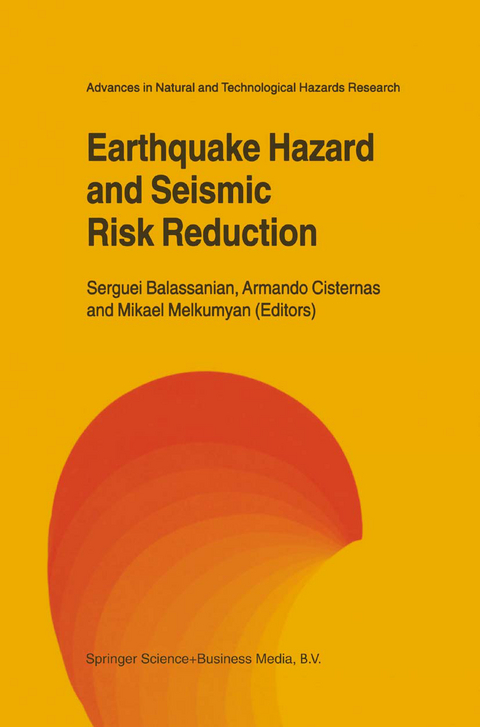
Earthquake Hazard and Seismic Risk Reduction
Springer (Verlag)
978-0-7923-6390-3 (ISBN)
I. Disaster Reduction.- Seismic Risk Reduction Strategy in the XXI Century.- Building Local Capacity for Earthquake Loss Reduction.- Disaster Assistance in Cold Weather Conditions: an Overview of Issues and Options.- Actual State of Technical Cooperation on Earthquake Disaster Prevention Case Study: JICA Earthquake Disaster Prevention Project in Mexico.- Radius Initiative for IDNDR a Practical Approach to Reduce Urban Seismic Risk.- Urban Seismic Risk Mitigation in Asia: Examples From Radius Case Studies.- The Kathmandu Valley Earthquake Risk Management Project (KVERMP): Project Motivation and Description.- The Role of the Subjective Factors in the Seismic Risk.- II. Earthquake Hazard.- Major and Great Earthquakes on the Himalayan Region: an Overview.- Seismicity of the Spitak Earthquake Source Zone Vicinity.- Southern Javakhet Earthquake Swarm. Stress Tensor Orientation Derived from Focal Mechanism Data.- The Digital Accelerograph Network in the Caucasus.- Implications of the Duration of Strong Ground Motion: (Observations from the U.S. Loma Prieta Earthquake of Oct. 17, 1989).- Seismicity and Cultural Monuments of Georgia.- Geomorphological Aspects of the Forming of Earthquake Intensity Effect in Highlands.- On Estimation of Dominant Vibration Periods of Site.- A Major Neotectonic Structure Within the Arabia — Eurasia Collisional Orogen: the Ararat — Araks Conjugate Fault System and its Possible Impact on the Safety of the Metsamor Nuclear Power Plant.- One Inequality of Elastokinetics and its Application in Seismology.- Earthquake Prediction Research for Current Seismic Hazard Assessment in Armenia.- The Stages of Earthquake Preparation: Laboratory Experiment and Field Study.- Earthquake Prediction: Pro and Contra.- Method of Analysis of Geochemical Oscillationsto Earthquake Prediction.- Earthquake Prediction Research in China: Zhangbei Ms=6.2 Earthquake on January 10, 1998.- Intense Crustal Deformation Rates on Nissyros Island (Greece), Deduced from GPS Studies, May Foreshadow a Forthcoming Volcanic Event.- Tectonic Early Warning System Through Real-Time Radon (Rn) Monitoring: Preliminary Results of a Geophysical Method for Forecasting Earthquakes.- The Results of Theoretical Researches of the Geodesic-Deformed Herald of Earthquakes.- Seismic Hazard Zonation in Eastern Europe.- A New Seismic Hazard Map for the Implementation in the National Physical Planning of Iran.- III. Earthquake Engineering.- Ten Years After the 1988 Spitak Earthquake: Reconstruction and New Lines of Earthquake Engineering Development in Armenia.- The Lessons of Armenia-Spitak, 1988, and Other Recent Earthquakes in View of Seismic Building Codes Improvement.- The Nature of Spitak Earthquake Occurred on December 7, 1988. Reinforcement and Repair Technology of Buildings and Constructions.- Some Structural Aspects of Buildings Destroyed in the Spitak Earthquake.- Seismic Upgrading of Existing Stone-Masonry Buildings: Lessons From the Earthquake of Bovec of 1998.- On Basic Concepts for Development of United International Earthquake Resistant Construction Code.- Analysis of New Seismic Building Codes of CIS Countries.- Recent Techniques and Regulations on Seismic Retrofit and Diagnosis for Buildings in Japan.- Some Main Principles of New Republic Codes on Design and Construction of Seismic- Resistant Masonry Structures.- Internet Availability of the Vulnerability Database.- Assessment of Damage and Usability of Earthquake-Damaged Buildings: Experience of Slovenia.- Design and Testing of High Damping Rubber Earthquake Bearings for Retrofit Project in Armenia.- The Research, Application and Design Code of Seismic Isolation and Energy Dissipation in China.- On one Approach of Studying the Free and Forced Vibrations of Bases and Fundaments of Structures.- Activities of the European Laboratory for Structural Assessment for Seismic Risk Reduction in Europe.- Effects of Incoherence, Wave Passage and Spatially Varying Site Conditions on Bridge Response.- The Impact of the System of Ties Upon the Level of Seismic Effect for Road Beam Bridges.- The Asymptotic Solution of Some Model Problems of Seismostability Construction and Seismology.
| Erscheint lt. Verlag | 31.8.2000 |
|---|---|
| Reihe/Serie | Advances in Natural and Technological Hazards Research ; 12 |
| Zusatzinfo | 314 Illustrations, black and white; XIV, 447 p. 314 illus. |
| Verlagsort | Dordrecht |
| Sprache | englisch |
| Maße | 155 x 235 mm |
| Themenwelt | Naturwissenschaften ► Biologie ► Ökologie / Naturschutz |
| Naturwissenschaften ► Geowissenschaften ► Geologie | |
| Naturwissenschaften ► Geowissenschaften ► Geophysik | |
| Naturwissenschaften ► Geowissenschaften ► Hydrologie / Ozeanografie | |
| Sozialwissenschaften ► Soziologie | |
| Technik ► Bauwesen | |
| ISBN-10 | 0-7923-6390-6 / 0792363906 |
| ISBN-13 | 978-0-7923-6390-3 / 9780792363903 |
| Zustand | Neuware |
| Haben Sie eine Frage zum Produkt? |
aus dem Bereich


